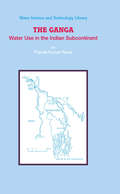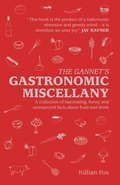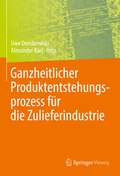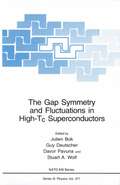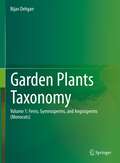- Table View
- List View
GaN Technology: Materials, Manufacturing, Devices and Design for Power Conversion
by Maurizio Di Paolo EmilioThis book provides an extensive examination of the practical implementations and theoretical foundations of circuit design with Gallium Nitride (GaN) devices. Designed with scientists and engineers in mind, the advanced studies detailed in this book provide invaluable insights into new methodologies and approaches, serving as a comprehensive guide for those embarking on innovative design endeavors.
The Ganga: Water Use in the Indian Subcontinent (Water Science and Technology Library #64)
by Pranab Kumar ParuaFrom time immemorial the Bengal Delta had been an important maritime des- nation for traders from all parts of the world. The actual location of the port of call varied from time to time in line with the natural hydrographic changes. From the early decades of the second millennium AD, traders from the European con- nent also joined the traders from the Arab countries, who had been the Forerunners in maritime trading with India. Daring traders and fortune seekers from Denmark, Holland, Belgium and England arrived at different ports of call along the Hooghly river. The river had been, in the meantime, losing its pre-eminence as the main outlet channel of the sacred Ganga into the Bay of Bengal, owing to a shift of ?ow towards east near Rajmahal into the Padma, which had been so long, carried very small part of the large volume of ?ow. On a cloudy afternoon on August 24, 1690 the British seafarer Job Charnock rested his oars at Kolkata and started a new chapter in the life of a sleepy village, bordering the Sunderbans which was ‘a tangled region of estuaries, rivers and water courses, enclosing a vast number of islands of various shapes and sizes. ’ and infested with a large variety of wild animals. In the language of the British Nobel Laureate (1907) Rudyard Kipling (1865–1936). ???? ???? Thus the midday halt of Charnock grew a city.
The Ganges Water Diversion: Environmental Effects and Implications (Water Science and Technology Library #49)
by M. Monirul Qader MirzaThis book deals with environmental effects on both sides of the border between Bangladesh and India caused by the Ganges water diversion. This issue came to my attention in early 1976 when news media in Bangladesh and overseas, began publications of articles on the unilateral withdrawal of a huge quantity of water from the Ganges River through the commissioning of the Farakka Barrage in India. I first pursued the subject professionally in 1984 while working as a contributor for Bangladesh Today, Holiday and New Nation. During the next two decades, I followed the protracted hydro-political negotiations between the riparian countries in the Ganges basin, and I traveled extensively to observe the environmental and ecological changes in Bangladesh as well as India that occurred due to the water diversion. The Ganges, one of the longest rivers of the world originates at the Gangotri glacier in the Himalayas and flows across the plains of North India. Eventually the river splits into two main branches and empties into the Bay of Bengal. The conflict of diversion and sharing of the Ganges water arose in the middle of the last century when the government of India decided to implement a barrage at Farakka to resolve a navigation problem at the Kolkata Port.
The Gannet's Gastronomic Miscellany
by Killian Fox The GannetA FINANCIAL TIMES BOOK OF THE YEAR 2017 'This is the first physical manifestation of a much-loved online magazine that is a monument to Fox's obsessions. One for the bedside table.' - FINANCIAL TIMES 'This book is the product of a ludicrously obsessive and greedy mind - it is therefore an utter joy.' - JAY RAYNER 'Your consummate culinary guide' - THE GUARDIAN 'A vital work from a keen mind full to brimming with wonderful thoughts and ideas.' - JEREMY LEE 'The most original, entertaining and downright fascinating book.' - DAVE BROOM 'Exercise caution before you buy this book. In fact, be careful about even flipping it open. You think Instagram is addictive? Ha. This book is as essential and educational as it is delightful and weird, and I need someone to come rescue me immediately because I cannot seem to put the damn thing down.' - JEFF GORDINIER, FOOD & DRINKS EDITOR, ESQUIRE MAGAZINE 'Going beyond the usual food fixations, the book is presented in a fresh, visually inventive style that will appeal to anyone with even a passing interest in food.' - DARINA ALLEN, IRISH EXAMINER gannetnoun1. a large seabird with mainly white plumage, which catches fish by plunging into the water.2. British informal, a greedy person.The Gannet's Gastronomic Miscellany goes beyond the usual food fixations. Presented in a fresh, visually inventive style, it will appeal to anyone with a passing interest in food - which, in this gastronomy-obsessed age, is pretty much all of us.In this compendious hotpot of a book you'll find a guide to creating a hit food profile on Instagram, a cross-section of a tiffin box, an explainer on craft beer, the origin story of Chicken Marengo, a list of millennia-old products that are still edible today (should you be brave enough to try Irish bog butter or Ancient Egyptian honey) and many more delightful nuggets of information.
Ganoderma: Cultivation, Chemistry, and Medicinal Applications, Volume 2
by Krishnendu Acharya Somanjana KhatuaFor the past two millennia, Ganoderma has been prized as the "mushroom of immortality" in ancient Asian cultures, owing to its health benefits. Modern research has further revealed that the genus is rich in bioactive components, including polysaccharides and triterpenoids, uncovering various medicinal prospects both in vitro and in vivo. Clinical trials conducted so far have emphasized the safe and effective use of the mushrooms, with a particular focus on Ganoderma lucidum. Currently, the Ganoderma-based industry is witnessing a significant surge, offering a plethora of dietary and medicinal products. Recognizing the impact of these developments, the book Ganoderma: Cultivation, Chemistry, and Medicinal Applications Volume 2 aims to consolidate the latest information on the macrofungi, emphasizing its bioactive compounds, diverse therapeutic effects, and industrial applications.Key Features: This book provides a thorough exploration of Ganoderma polysaccharides, unraveling their chemical composition, structure, and potential health benefits. Comprehensive coverage is provided to understand antimicrobial properties of the medicinal mushrooms. The text also delves into the potential role of Ganoderma in safeguarding against various skin diseases, accompanied by discussions on underlying mechanisms. A detailed examination of Ganoderma includes its potential cardioprotective effects, encompassing impacts on blood pressure, cholesterol level, and overall heart function. This book also provides an in-depth analysis of the capacity of the macrofungi to stimulate the immune system. The volume encompasses findings related to the impact of Ganoderma on prevention or mitigation of neurodegenerative diseases. Additionally, it contributes to the understanding of medicinal applications by exploring Ganoderma-based nanoparticles, offering novel insights into potential therapeutic avenues. A comprehensive overview of the Ganoderma-inspired industry highlights its diverse contributions ranging from dietary supplements, cosmeceuticals, and nutricosmetics to healthcare products.
Ganoderma: Cultivation, Chemistry, and Medicinal Applications, Volume 2
For the past two millennia, Ganoderma has been prized as the "mushroom of immortality" in ancient Asian cultures, owing to its health benefits. Modern research has further revealed that the genus is rich in bioactive components, including polysaccharides and triterpenoids, uncovering various medicinal prospects both in vitro and in vivo. Clinical trials conducted so far have emphasized the safe and effective use of the mushrooms, with a particular focus on Ganoderma lucidum. Currently, the Ganoderma-based industry is witnessing a significant surge, offering a plethora of dietary and medicinal products. Recognizing the impact of these developments, the book Ganoderma: Cultivation, Chemistry, and Medicinal Applications Volume 2 aims to consolidate the latest information on the macrofungi, emphasizing its bioactive compounds, diverse therapeutic effects, and industrial applications.Key Features: This book provides a thorough exploration of Ganoderma polysaccharides, unraveling their chemical composition, structure, and potential health benefits. Comprehensive coverage is provided to understand antimicrobial properties of the medicinal mushrooms. The text also delves into the potential role of Ganoderma in safeguarding against various skin diseases, accompanied by discussions on underlying mechanisms. A detailed examination of Ganoderma includes its potential cardioprotective effects, encompassing impacts on blood pressure, cholesterol level, and overall heart function. This book also provides an in-depth analysis of the capacity of the macrofungi to stimulate the immune system. The volume encompasses findings related to the impact of Ganoderma on prevention or mitigation of neurodegenerative diseases. Additionally, it contributes to the understanding of medicinal applications by exploring Ganoderma-based nanoparticles, offering novel insights into potential therapeutic avenues. A comprehensive overview of the Ganoderma-inspired industry highlights its diverse contributions ranging from dietary supplements, cosmeceuticals, and nutricosmetics to healthcare products.
Ganoderma Diseases of Tropical Crops
by Dr Carmel A Pilotti Paul BridgeThe fungal genus Ganoderma includes around 80 currently recognized species that are widely distributed in temperate, subtropical and tropical regions, and cause disease in a range of economically important perennial crops and tree-like plants. Ganoderma root and lower stem rots have a significant impact on yields from crops including oil palm, coconut, beverage crops, Acacia and rubber. The identification of species responsible for stem and butt rots is often ambiguous as closely related species may only be distinguished by subtle morphological differences. Within species there can be considerable morphological plasticity and this can make morphology-based identification difficult, particularly for species described from a single specimen. Molecular techniques are helping to slowly resolve Ganoderma taxonomy but it will be some time (if ever) before the taxonomy is fully resolved. This book brings together information on Ganoderma species that are reported to be responsible for crop diseases in tropical and sub-tropical agriculture and covers taxonomy, biology, genetics, aetiology, epidemiology and control. This book is an essential resource for researchers in Ganoderma in crop science and tropical agriculture, as well as practitioners and industry.
GANs for Data Augmentation in Healthcare
by Arun Solanki Mohd NavedComputer-Assisted Diagnostics (CAD) using Convolutional Neural Network (CNN) model has become an important technology in the medical industry, improving the accuracy of diagnostics. However, the lack Magnetic Resonance Imaging (MRI) data leads to the failure of the depth study algorithm. Medical records are often different because of the cost of obtaining information and the time spent consuming the information. In general, clinical data is unreliable and therefore the training of neural network methods to distribute disease across classes does not yield the desired results. Data augmentation is often done by training data to solve problems caused by augmentation tasks such as scaling, cropping, flipping, padding, rotation, translation, affine transformation, and color augmentation techniques such as brightness, contrast, saturation, and hue. Data Augmentation and Segmentation imaging using GAN can be used to provide clear images of brain, liver, chest, abdomen, and liver on an MRI. In addition, GAN shows strong promise in the field of clinical image synthesis. In many cases, clinical evaluation is limited by a lack of data and/or the cost of actual information. GAN can overcome these problems by enabling scientists and clinicians to work on beautiful and realistic images. This can improve diagnosis, prognosis, and disease. Finally, GAN highlights the potential for location of patient information within the data. This is a beneficial clinical application of GAN because it can effectively protect patient confidentiality. This book covers the application of GANs on medical imaging augmentation and segmentation.
Ganzheitliche Bewertung modularer Ladungsträgerkonzepte: Eine Lebenszyklusbetrachtung (AutoUni – Schriftenreihe #93)
by Antje RosenthalAntje Rosenthal hat ein ganzheitliches Bewertungsmodell entwickelt, das alle während der Entstehung, Nutzung sowie Entsorgung des Ladungsträgers anfallenden Kosten und Erlöse in die Ermittlung der sogenannten Lebenszykluskosten einbezieht. Die Autorin zeigt, dass die modulare Gestaltung von Ladungsträgern durch den Einsatz und die Wiederverwendung standardisierter Komponenten einen wesentlichen Beitrag zur Reduzierung und Vermeidung von Komplexität und damit einhergehenden Kosten leisten kann. Je höher der Grad der Wiederverwendung von Komponenten und Modulen ist, desto höher fällt das Kosteneinsparungspotenzial aus. Mithilfe des Modells kann auch die Entscheidungsfindung zwischen einem Spezial- und einem modularen Ladungsträgerkonzept unterstützt werden, um so die Mehrkosten einer modularen Produktstruktur eines Ladungsträgerkonzeptes zu bewerten.
Ganzheitliche Bilanzierung: Werkzeug zum Planen und Wirtschaften in Kreisläufen
by Peter EyererDie "life-cycle-analysis" mit dem Instrument der Ganzheitlichen Bilanzierung ermöglicht Unternehmen konstruktive Verbesserungen, Kosteneinsparungen und eine weitergehende Schonung der Umwelt. Namhafte Fachleute beschreiben detailliert und umfassend die Grundlagen, Methoden, (Rechner-)Werkzeuge und Bewertungskriterien der Ganzheitlichen Bilanzierung.
Ganzheitliche Fabrikplanung: Grundlagen, Vorgehensweise, EDV-Unterstützung (VDI-Buch)
by Günther PawellekDie Überarbeitung der 2. Auflage umfasst die Investitionsrechenverfahren, die Standortplanung im Produktionsnetzwerk, die energieeffiziente Fabrikplanung, Methoden der Produktionsstrukturplanung, die Unterstützung des Projektmanagements mit Handhelp-Systemen sowie das Methoden-Management. Neue Planungsbeispiele, wie bspw. die Einrichtung eines montagenahen Supermarktes oder eines Produktionslogistikkonzeptes, verstärken den Anwendungsbezug.Planer und Entscheider erhalten einen Leitfaden für die Neu-, Erweiterungs- oder Rationalisierungsplanung. Der ganzheitliche Ansatz umfasst dabei die gesamte Planungstiefe, von der Strategie- über die Struktur- und Systemplanung bis hin zur Ausführungsplanung und Inbetriebnahme. Ebenso wird die gesamte Planungsbreite über alle Funktionssysteme und Gewerke, wie z.B. Fertigung und Montage, Lagerung und innerbetrieblicher Transport, Organisation, Gebäude und Infrastruktur mit ihren Abhängigkeiten behandelt. Grundsätzlich erfordert die Fabrikplanung als komplexe Aufgabenstellung ein zielgerichtetes und strukturiertes Vorgehen, Konzentration auf das Wesentliche und Wahl der richtigen Methoden und Instrumente, sollen Fehlinvestitionen vermieden werden.
Ganzheitliche Fabrikplanung: Grundlagen, Vorgehensweise, EDV-Unterstützung (VDI-Buch)
by Günther PawellekIn einer ganzheitlichen und doch detaillierten Übersicht beschreibt der Autor die Fabrikplanung mit ihren planungstechnischen Grundlagen, Vorgehensweisen, Methoden und EDV-Tools. Schwerpunkt des Buches ist die problembezogene Planungs- und Entscheidungssystematik. Neue Anforderungen und Lösungsansätze der „Fabrik der Zukunft" werden ebenso berücksichtigt wie traditionelle und bewährte Ansätze. Das Buch ist ein Leitfaden für die Planung komplexer Projekte und stellt die wichtigsten Methoden und aktuellsten Instrumente zur EDV-Unterstützung dar.
Ganzheitliche Gestaltung mobiler Arbeit (ifaa-Edition)
by ifaa – Institut für angewandte Arbeitswissenschaft e. V.Das zunehmende Interesse an mobiler Arbeit sowohl bei Unternehmen als auch bei Beschäftigten führt auf betrieblicher Ebene zu Gestaltungsherausforderungen. Aufgrund des heterogenen Verständnisses von mobiler Arbeit und den unterschiedlichen Motivationen der Beteiligten erscheint "die eine beste Lösung" zur Einführung von mobiler Arbeit im Betrieb nicht realistisch. Bereits gemachte Praxiserfahrungen untermauern diese These. Es existieren zwar vielfältige Unterstützungstools, die auch genutzt werden (können), diese Checklisten, Handlungshilfen etc. adressieren in der Regel aber nur ein relevantes Thema von vielen, bei der Einführung von mobiler Arbeit, die es zu bewältigen gilt. Vor diesem Hintergrund hat das ifaa – Institut für angewandte Arbeitswissenschaft e. V. ein Rahmenkonzept entwickelt, das die ganzheitliche Gestaltung und Einführung mobiler Arbeit in den Blick nimmt und die Betriebe bei der Einführung mobiler Arbeit unterstützt.
Ganzheitliche Methodik zur Analyse und Kompensation von ansteuerungsbedingten Störungen im Regelkreis permanenterregter Synchronmaschinen (Wissenschaftliche Reihe Fahrzeugtechnik Universität Stuttgart)
by Eugen SworowskiEugen Sworowski befasst sich mit ansteuerungsbedingten Störungen im Regelkreis permanenterregter Synchronmaschinen. Er gibt eine Methodik zur einheitlichen Beschreibung solcher Störungen an. Seine Schwerpunkte liegen dabei auf der Berücksichtigung der Feldschwächung und des Stromregelkreises. Anhand dieser Methodik erfolgt die Entwicklung von Kompensationen für relevante Störungen in dieser Forschungsarbeit. Hierzu zählen die Offset- und Verstärkungsstörungen der Strommessung, Ordnungsstörungen des Rotorlagewinkels und Störungen durch Schutzzeiten des Wechselrichters.
Ganzheitliche Produktionsplanung und -steuerung: Konzepte für Produktionsunternehmen mit kombinierter kundenanonymer und kundenbezogener Auftragsabwicklung (fir+iaw Forschung für die Praxis #33)
by Winfried BüdenbenderGanzheitliche Produktionssysteme: Aktueller Stand und zukünftige Entwicklungen (VDI-Buch)
by Uwe Dombrowski Tim MielkeKaum ein Unternehmen kann es sich heutzutage leisten, die Potenziale Ganzheitlicher Produktionssysteme (GPS) ungenutzt zu lassen. Mit GPS werden herausragende Erfolge bei der Verbesserung der Qualität, der Reduzierung von Durchlaufzeiten und der Steigerung der Produktivität sowie zahlreicher weiterer Zielgrößen ermöglicht. GPS haben ihren Ursprung zwar in der Automobilindustrie, inzwischen haben sie sich aufgrund des großen Erfolgs jedoch in verschiedensten Branchen als Industriestandard etabliert. Dieses Buch bietet eine umfassende Darstellung der Thematik und stellt hierfür die relevanten Inhalte zu Grundlagen, Einführung und Weiterentwicklung vor. Die grundlegende Struktur Ganzheitlicher Produktionssysteme wird systematisch anhand der Gestaltungsprinzipien der VDI 2870 beschrieben und mit zahlreichen Praxisbeispielen erläutert. Auf diese Weise erhält der Leser viele interessante Einblicke und Erkenntnisse für Praxis, Forschung und Lehre.
Ganzheitliche Projektabwicklung: Konsequent partnerschaftlich - integrativ - kollaborativ
by Sandra IbromGanzheitliche Projektabwicklung ist eine grundlegend neue Philosophie und Herangehensweise wie Baurojekte jeder Größenordnung menschlich und daher auch wirtschaftlich erfolgreich abgewickelt werden können. Dabei wird aktuelles Management-, Führungs- sowie Kommunikationswissen zusammengeführt und durch radikal vereinfachte und kooperationsfreundliche Vertragsgestaltungen rechtlich gestützt. Sie ist die Grundlage einer neuen Kultur in der Projektabwicklung. Durch den umfassenden mediativen Ansatz wird der notwendige Umkehrprozess ermöglicht, weg von dem bisherigen Gegeneinander und hin zu einer für alle Beteiligten und Betroffenen gewinnbringenden Zusammenarbeit. So macht Arbeiten in Bauprojekten wieder Spaß und ermöglicht nachhaltige Wertschöpfung im und durch das Projekt.
Ganzheitlicher Produktentstehungsprozess für die Zulieferindustrie
by Uwe Dombrowski Alexander KarlDer Produktentstehungsprozess erfordert auch von kleinen und mittleren Lieferanten zunehmend eine übergreifende Koordination. Dies resultiert zum einen aus den steigenden Anforderungen an den Produktentstehungsprozess, zum anderen verlagern Unternehmen einen wachsenden Anteil ihrer Entwicklungsleistung auf Lieferanten. Um signifikante Verbesserungen im Bereich der Entwicklungszeit, -kosten sowie -qualität zu erzielen, ist eine systematische Integration der Lieferanten notwendig. Zur Steigerung der Effektivität und Effizienz ist es erforderlich, dass alle Partner innerhalb des Wertschöpfungsnetzwerks nach gleichen Prinzipien und Methoden arbeiten. Bestehende Lean Development-Ansätze der Hersteller müssen auf Lieferanten übertragen, angepasst und deren Schnittstellen zwischen Hersteller und Lieferanten ausgestaltet werden. Das Buch liefert strukturiert und übersichtlich wichtige Grundlagen und studiengestützte Informationen zur Optimierung dieser Zusammenarbeit.
Ganzheitliches Life Cycle Management: Nachhaltigkeit und Lebenszyklusorientierung in Unternehmen (VDI-Buch)
by Christoph HerrmannWenn Unternehmen die Anforderungen einer nachhaltigen Entwicklung umsetzen, stehen sie vor der zentralen Aufgabe, Produkte und Prozesse lebensphasenübergreifend zu betrachten. Der Autor stellt die Gestaltungsmöglichkeiten des Life Cycle Managements vor und unterscheidet zwischen lebensphasenbezogenen Disziplinen wie z. B. dem Produkt- und Produktions-Management sowie lebensphasenübergreifenden Disziplinen (z. B. Informations- und Wissensmanagement). Zahlreiche Anwendungsbeispiele und Abbildungen dienen der Veranschaulichung der Inhalte.
Ganzheitliches Produktionsmanagement: Strategischer Rahmen und operative Umsetzung
by Uwe Dombrowski Philipp KrenkelDie Produktion stellt einen entscheidenden Wettbewerbsfaktor zur Herstellung diversifizierter, kundenindividueller Produkte dar. Wesentlich sind die Kundenorientierung, die Vermeidung von Verschwendung und die kontinuierliche Verbesserung der Produktionsprozesse. Hierfür ist eine ganzheitliche Betrachtung des Produktionsmanagements notwendig, wobei es vielzählige Handlungsfelder zu berücksichtigen gilt. In diesem Fachbuch werden diese Handlungsfelder des Produktionsmanagements praxisgerecht und methodisch-strukturiert beschrieben. Ausgehend von der Ausarbeitung einer Produktionsstrategie erfolgt die Beschreibung der Umsetzung und Verbesserung des operativen Produktionsmanagements. Detailliert wird auf die elementaren Grundlagen wie Technologiemanagement, Lean Production, Supply Chain Management, Facility Management, Human Resource Management und weiteres eingegangen. Da sich die Produktionsmethoden und -verfahren in den vergangenen Jahren maßgeblich verändert haben, erhält der Leser darüber hinaus fundiert beschriebene Einblicke in aktuelle Weiterentwicklungen des Produktionsmanagements. Eine besondere Rolle nehmen hierbei Informations- und Kommunikationstechnologien bzw. die Industrie 4.0 ein.
GaP Heteroepitaxy on Si: Benchmarking Surface Signals when Growing GaP on Si in CVD Ambients (Springer Theses)
by Henning DöscherEpitaxial integration of III-V semiconductors on silicon substrates has been desired over decades for high application potential in microelectronics, photovoltaics, and beyond. The performance of optoelectronic devices is still severely impaired by critical defect mechanisms driven by the crucial polar-on-nonpolar heterointerface. This thesis reports almost lattice-matched growth of thin gallium phosphide films as a viable model system for III-V/Si(100) interface investigations. The impact of antiphase disorder on the heteroepitaxial growth surface provides quantitative optical in situ access to one of the most notorious defect mechanisms, even in the vapor phase ambient common for compound semiconductor technology. Precise control over the surface structure of the Si(100) substrates prior to III-V nucleation prevents the formation of antiphase domains. The hydrogen-based process ambient enables the preparation of anomalous double-layer step structures on Si(100), highly beneficial for subsequent III-V integration.
The Gap Symmetry and Fluctuations in High-Tc Superconductors (Nato Science Series B: #371)
by Julien Bok Guy Deutscher Davor Pavuna Stuart A. WolfSince the discovery in 1986 of high temperature superconductors by J. G. Bednorz and K. A. Müller, a considerable progress has been made and several important scientific problems have emerged. Within this NATO Advanced Study Institute our intention was to focus mainly on the controversial topic of the symmetry of the superconducting gap and given the very short coherence length, the role of fluctuations. The Institute on ‘The Gap Symmetry and Fluctuations in High- Superconductors’ took place in the “Institut d’Etudes Scientifiques de Cargèse” in Corsica, France, between 1 - 13 September 1997. The 110 participantsfrom 18 countries (yet 30 nationalities) including 23 full time lecturers, have spent two memorable weeks in this charming Mediterranean resort. All lecturers were asked to prepare pedagogical papers to clearly present the central physical idea behind specific model or experiment. The better understanding of physics of high temperature superconductivity is certainly needed to guide the development of applications of these materials in high and weak current devices.
Garbage Crisis: A Global Challenge for Engineers (Synthesis Lectures on Engineers, Technology, & Society)
by Randika Jayasinghe Usman Mushtaq Toni Smythe Caroline BaillieThis book will focus on "Waste Management," a serious global issue and engineers' responsibility towards finding better solutions for its sustainable management. Solid waste management is one of the major environmental burdens in both developed and developing countries alike. An alarming rate of solid waste generation trends can be seen as a result of globalization, industrialization, and rapid economic development. However, low-income and marginalized sectors in society suffer most from the unfavorable conditions deriving from poor waste management. Solid waste management is not a mere technical challenge. The environmental impact, socio-economic, cultural, institutional, legal, and political aspects are fundamental in planning, designing, and maintaining a sustainable waste management system in any country. Engineers have a major role to play in designing proper systems that integrate stakeholders, waste system elements, and sustainability aspects of waste management. This book is part of a focused collection from a project on Engineering and Education for Social and Environmental Justice. It takes an explicitly social and environmental justice stance on waste and attempts to assess the social impact of waste management on those who are also the most economically vulnerable and least powerful in the society. We hope that this book will assist our readers to think critically and understand the framework of socially and environmentally just waste management. Table of Contents: Introduction / Towards a Just Politics of Waste Management / Expertise, Indigenous People, and the Site 41 Landfill / Waste Management in the Global North / Waste Management in the Global South: A Sri Lankan Case Study / Assessing the Feasibility of Waste for Life in the Western Province of Sri Lanka
Garden Plants Taxonomy: Volume 1: Ferns, Gymnosperms, and Angiosperms (Monocots)
by Bijan DehganHorticulture has remained far behind in understanding of botanical principles. Recent phylogenetic (DNA-based) reorganization of higher plants has revolutionized taxonomic treatments of all biological entities, even when morphology does not completely agree with their organization. This book is an example of applying principals of botanical phylogenetic taxonomy to assemble genera, species, and cultivars of 200 vascular plant families of ferns, gymnosperms, and angiosperms that are cultivated for enhancement of human living space; homes, gardens, and parks. The emphases are on cultivated species but examples of some plants are often shown in the wild and in landscapes. In providing descriptions, it is assumed that students and other interested individuals have no background in general botany (plant characteristics), or nomenclature. Fundamental features of all plant groups discussed are fully illustrated by original watercolor drawings or photographs. Discussion of the families is grounded on recent botanical phylogenetic treatments, which is based on common ancestry (monophyly). Of course, phylogenetic taxonomy is not a new concept, and was originally based on morphological characteristics; it is the DNA-based phylogeny that has revolutionized modern biological classifications. In practical terms, this book represents the horticultural treatment that corresponds to phylogenetic-based botanical taxonomy, to which is added cultigens and cultivated genera and species. Hence, the harmony between horticultural and botanical taxonomy. This book covers phylogenetic-based taxonomy of Ferns, Gymnosperms, and Angiosperms (Monocots). A companion volume covers Angiosperms (Eudicots).
Gardener’s Almanac 2025: A Month-by-month Guide For Gardening Enthusiasts
by Greg LoadesPacked with new features and advice, the 2025 edition of this guide remains a perfect gift for any gardener. Month by month, there's timely gardening advice and information from the National Trust, together with inspiring writing and beautiful illustrations. Every month includes: Weather charts - sunrise and sunset, average temperatures A task to start; a task to finish Pruning made simple A recycling project If you only do one thing… Crop of the month Something to savour House plant of the month Wildlflower focus Trivia - Facts too good to keep to yourself Quotations - Wit and wisdom from famous gardeners, past and present There's information on enjoying other gardens too - with dates for open gardens around the country, including from the National Trust and RHS.

